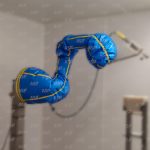Our protective covers for robots are designed to withstand the high friction caused by the hoses used in shotblasting, stripping, and cold forging processes.
When manufacturing a protective cover for a shotblasting robot, a precise technical analysis of the stresses to which the robot is subjected is necessary. This analysis is carried out by our experienced Methods technicians in collaboration with the technical sales team, in order to address each customer’s specific requirements. Our high-quality protective covers fully protect your robot during operation, helping to reduce costly maintenance operations and expenses.
It is possible to replace only the damaged part of the protective cover. Generally, wrist joint covers need to be replaced more frequently than robot body covers or base covers because they are located close to the production tool and thus closer to projections.
The ASP manufacturing process is rigorous, with cutting, assembly, sealing, and quality control phases performed by our operators in the manufacturing department, ensuring optimal use of your robot protective cover. To achieve this, ASP always works closely with the customer to develop a specific and tailored protection solution to match their needs.




